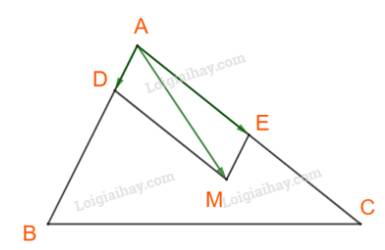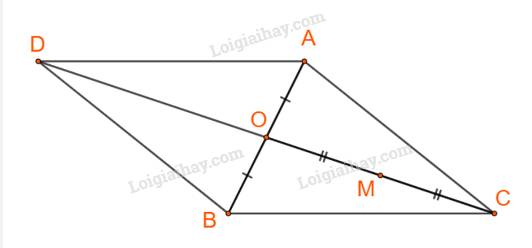Cho tứ giác ABCD , xác định các điểm M ,N , P sao cho
a , \(2\overrightarrow{MA}+\overrightarrow{MB}+\overrightarrow{MC}=\overrightarrow{0}\)
Cho tứ giác ABCD, tìm tập hợp điểm M sao cho: \(2\overrightarrow{MA}+3\overrightarrow{MB}-\overrightarrow{MC}+4\overrightarrow{MD}=\overrightarrow{0}\)
Cho tứ giác ABCD. Tìm tập hợp các điểm M sao cho \(|\overrightarrow{MA}+\overrightarrow{MB}+\overrightarrow{MC}+\overrightarrow{MD}|\) = \(|\overrightarrow{MA}+\overrightarrow{MB}-2\overrightarrow{MC}|\)
Cho tam giác ABC
1/ Xác định I sao cho \(\overrightarrow{IB}+\overrightarrow{IC}-\overrightarrow{IA}=0\)
2/ Tìm điểm M thỏa mãn \(\overrightarrow{MA}-\overrightarrow{MB}+2\overrightarrow{MC=0}\)
1.
\(\overrightarrow{IB}+\overrightarrow{IC}+\overrightarrow{AI}=\overrightarrow{0}\Leftrightarrow\overrightarrow{IB}+\overrightarrow{AC}=0\)
\(\Leftrightarrow\overrightarrow{IB}=\overrightarrow{CA}\)
\(\Rightarrow\) I là 1 đỉnh của hình bình hành ABIC
2.
Gọi N là trung điểm AB \(\Rightarrow\overrightarrow{AN}=\dfrac{1}{2}\overrightarrow{AB}\)
\(\overrightarrow{MA}+\overrightarrow{BM}+2\overrightarrow{MC}=\overrightarrow{0}\Leftrightarrow\overrightarrow{BA}+2\overrightarrow{MC}=\overrightarrow{0}\)
\(\Leftrightarrow\overrightarrow{MC}=\dfrac{1}{2}\overrightarrow{AB}\Leftrightarrow\overrightarrow{MC}=\overrightarrow{AN}\)
\(\Rightarrow\) M là 1 đỉnh của hình bình hành ANCM
cho tứ giác ABCD , xác định các điểm M , N , P sao cho
a , \(2\overrightarrow{MA}+\overrightarrow{MB}+\overrightarrow{MC}=\overrightarrow{0}\)
Gọi G là trọng tâm tam giác ABC
\(2\overrightarrow{MA}+\overrightarrow{MB}+\overrightarrow{MC}=\overrightarrow{0}\)
\(\Leftrightarrow2\left(\overrightarrow{MG}+\overrightarrow{GA}\right)+\overrightarrow{MG}+\overrightarrow{GB}+\overrightarrow{MG}+\overrightarrow{GC}=\overrightarrow{0}\)
\(\Leftrightarrow4\overrightarrow{MG}+\overrightarrow{GA}+\overrightarrow{GA}+\overrightarrow{GB}+\overrightarrow{GC}=\overrightarrow{0}\)
\(\Leftrightarrow4\overrightarrow{MG}+\overrightarrow{GA}=\overrightarrow{0}\)
\(\Leftrightarrow\overrightarrow{MG}=\frac{1}{4}\overrightarrow{AG}\)
cho Tứ giác ABCD có E, F là trung điểm AB, CD. O là trung điểm của EF
a) Chứng minh \(\overrightarrow{AD}+\overrightarrow{BC}=2\overrightarrow{EF}\)
b) Chứng minh \(\overrightarrow{OA}+\overrightarrow{OB}+\overrightarrow{OC}+\overrightarrow{OD}=\overrightarrow{0}\)
c) Chứng minh \(\overrightarrow{MA}+\overrightarrow{MB}+\overrightarrow{MC}+\overrightarrow{MD}=4\overrightarrow{MO}\)
d) Xác định M để \(\overrightarrow{MA}+\overrightarrow{MB}+\overrightarrow{MC}+\overrightarrow{MD}\) nhỏ nhất
Cho tam giác ABC cố định
a) Xác định điểm I sao cho : \(\overrightarrow{IA}+3\overrightarrow{IB}-2\overrightarrow{IC}=\overrightarrow{0}\)
b) Lấy điểm M di động. Vẽ điểm N sao cho : \(\overrightarrow{MN}=\overrightarrow{MA}+3\overrightarrow{MB}-2\overrightarrow{MC}\)
Chứng minh rằng MN luôn đi qua một điểm cố định
a) Giả sử điểm I thỏa mãn:
\(\overrightarrow{IA}+3\overrightarrow{IB}-2\overrightarrow{IC}=\overrightarrow{0}\)\(\Leftrightarrow\overrightarrow{IA}-\overrightarrow{IC}+\overrightarrow{IB}-\overrightarrow{IC}+2\overrightarrow{IB}=\overrightarrow{0}\)
\(\Leftrightarrow\overrightarrow{CA}+\overrightarrow{CB}+2\overrightarrow{IB}=\overrightarrow{0}\)
\(\Leftrightarrow2\overrightarrow{IB}=\overrightarrow{AC}+\overrightarrow{BC}\)
\(\Leftrightarrow\overrightarrow{IB}=\dfrac{\overrightarrow{AC}+\overrightarrow{BC}}{2}\).
Xác định véc tơ: \(\dfrac{\overrightarrow{AC}+\overrightarrow{BC}}{2}\).
Dựng điểm B' sao cho \(\overrightarrow{BC}=\overrightarrow{CB'}\).
\(\overrightarrow{AC}+\overrightarrow{BC}=\overrightarrow{AC}+\overrightarrow{CB'}=\overrightarrow{AB'}\).
\(\dfrac{\overrightarrow{AC}+\overrightarrow{BC}}{2}=\dfrac{\overrightarrow{AB'}}{2}\).
Dựng điểm I sao cho \(\overrightarrow{IB}=\dfrac{\overrightarrow{AC}+\overrightarrow{BC}}{2}=\overrightarrow{AK}\) (K là trung điểm của AB').
b) Tìm điểm I sao cho: \(\overrightarrow{IA}+3\overrightarrow{IB}-2\overrightarrow{IC}=\overrightarrow{0}\) và chứng mịn điểm I cố định.
Có: \(\overrightarrow{IA}+3\overrightarrow{IB}-2\overrightarrow{IC}=\overrightarrow{IA}+3\overrightarrow{IB}+2\overrightarrow{CI}\)
\(=\left(\overrightarrow{CI}+\overrightarrow{IA}\right)+\left(\overrightarrow{CI}+\overrightarrow{IB}\right)+2\overrightarrow{IB}\)
\(=\overrightarrow{CA}+\overrightarrow{CB}+2\overrightarrow{IB}\).
Suy ra: \(\overrightarrow{CA}+\overrightarrow{CB}+2\overrightarrow{IB}=\overrightarrow{0}\)\(\Leftrightarrow\overrightarrow{IB}=\dfrac{\overrightarrow{AC}+\overrightarrow{BC}}{2}\)
Vậy điểm I xác định sao cho \(\overrightarrow{IB}=\dfrac{\overrightarrow{AC}+\overrightarrow{BC}}{2}\) .
Do A, B, C cố định nên tồn tại một điểm I duy nhất.
Theo giả thiết:
Có \(\overrightarrow{MN}=\overrightarrow{MA}+3\overrightarrow{MB}-2\overrightarrow{MC}\)\(=\overrightarrow{MI}+\overrightarrow{IA}+3\left(\overrightarrow{MI}+\overrightarrow{IB}\right)-2\left(\overrightarrow{MI}+\overrightarrow{IC}\right)\)
\(=2\overrightarrow{MI}+\overrightarrow{IA}+3\overrightarrow{IB}-2\overrightarrow{IC}\)
\(=2\overrightarrow{MI}\) (Do các xác định điểm I).
Vì vậy \(\overrightarrow{MN}=2\overrightarrow{MI}\) nên hai véc tơ \(\overrightarrow{MN},\overrightarrow{MI}\) cùng hướng.
Suy ra 3 điểm M, N, I thẳng hàng hay MN luôn đi qua điểm cố định I.
Cho tứ giác ABCD, I và J lần lượt là trung điểm của AB và CD. Tìm tập hợp điểm M sao cho
\(\overrightarrow{MA}.\overrightarrow{MB}+\overrightarrow{MC}.\overrightarrow{MD}=\dfrac{1}{2}.\overrightarrow{IJ}\)
Chắc chắn là đề bài sai rồi
Vế trái là 1 đại lượng vô hướng
Vế phải là 1 đại lượng có hướng (vecto)
Hai vế không thể bằng nhau được
Cho tứ giác ABCD . Tìm số k và điểm I cố định sao cho các tổng vectơ sau có thể viết dưới dạng \(\overrightarrow{k.MI}\) ∀ M
a, \(\overrightarrow{MA}+\overrightarrow{MB}-\overrightarrow{MC}=k\overrightarrow{MI}\)
b. \(\overrightarrow{MA}+\overrightarrow{MB}+2\overrightarrow{MC}=k\overrightarrow{MI}\)
c, \(\overrightarrow{MA}+\overrightarrow{MB}+\overrightarrow{MC}+\overrightarrow{MD}=k\overrightarrow{MI}\)
d, \(2\overrightarrow{MA}-3\overrightarrow{MC}+2\overrightarrow{MD}=k\overrightarrow{MI}\)
Cho tam giác ABC
a) Hãy xác định điểm M để \(\overrightarrow {MA} + \overrightarrow {MB} + 2\overrightarrow {MC} = \overrightarrow 0 \)
b) Chứng minh rằng với mọi điểm O, ta có \(\overrightarrow {OA} + \overrightarrow {OB} + 2\overrightarrow {OC} = 4\overrightarrow {OM} \)
Tham khảo:
a) Ta có: \(\overrightarrow {MA} + \overrightarrow {MB} + 2\overrightarrow {MC} = \overrightarrow 0 \Leftrightarrow \overrightarrow {MA} + \left( {\overrightarrow {MA} + \overrightarrow {AB} } \right) + 2\left( {\overrightarrow {MA} + \overrightarrow {AC} } \right) = \overrightarrow 0 \)
\(\begin{array}{l} \Leftrightarrow 4\overrightarrow {MA} + \overrightarrow {AB} + 2\overrightarrow {AC} = \overrightarrow 0 \\ \Leftrightarrow 4\overrightarrow {AM} = \overrightarrow {AB} + 2\overrightarrow {AC} \\ \Leftrightarrow \overrightarrow {AM} = \frac{1}{4}\overrightarrow {AB} + \frac{1}{2}\overrightarrow {AC} \end{array}\)
Trên cạnh AB, AC lấy điểm D, E sao cho \(AD = \frac{1}{4}AB;\;\,AE = \frac{1}{2}AC\)

Khi đó \(\overrightarrow {AM} = \overrightarrow {AD} + \overrightarrow {AE} \) hay M là đỉnh thứ tư của hình bình hành AEMD.
b) Chứng minh rằng với mọi điểm O, ta có \(\overrightarrow {OA} + \overrightarrow {OB} + 2\overrightarrow {OC} = 4\overrightarrow {OM} \)
Với mọi điểm O, ta có: \(\left\{ \begin{array}{l}\overrightarrow {OA} = \overrightarrow {OM} + \overrightarrow {MA} ;\;\\\overrightarrow {OB} = \overrightarrow {OM} + \overrightarrow {MB} ;\;\,\\\overrightarrow {OC} = \overrightarrow {OM} + \overrightarrow {MC} \end{array} \right.\)
\(\begin{array}{l} \Rightarrow \overrightarrow {OA} + \overrightarrow {OB} + 2\overrightarrow {OC} = \left( {\overrightarrow {OM} + \overrightarrow {MA} } \right) + \left( {\overrightarrow {OM} + \overrightarrow {MB} } \right) + 2\left( {\overrightarrow {OM} + \overrightarrow {MC} } \right)\\ = 4\overrightarrow {OM} + \left( {\overrightarrow {MA} + \overrightarrow {MB} + 2\overrightarrow {MC} } \right) = 4\overrightarrow {OM} + \overrightarrow 0 = 4\overrightarrow {OM} .\end{array}\)
Vậy với mọi điểm O, ta có \(\overrightarrow {OA} + \overrightarrow {OB} + 2\overrightarrow {OC} = 4\overrightarrow {OM} \).
Tham khảo cách 2 câu a:
Cách 2:
Ta có: \(\overrightarrow {MA} + \overrightarrow {MB} + 2\overrightarrow {MC} = \overrightarrow 0 \Leftrightarrow \left( {\overrightarrow {MC} + \overrightarrow {CA} } \right) + \left( {\overrightarrow {MC} + \overrightarrow {CB} } \right) + 2\overrightarrow {MC} = \overrightarrow 0 \)
\(\begin{array}{l} \Leftrightarrow 4\overrightarrow {MC} + \overrightarrow {CA} + \overrightarrow {CB} = \overrightarrow 0 \\ \Leftrightarrow 4.\overrightarrow {CM} = \overrightarrow {CA} + \overrightarrow {CB} \end{array}\)
Gọi D là đỉnh thứ tư của hình bình hành ACBD.
Khi đó: \(\overrightarrow {CD} = \overrightarrow {CA} + \overrightarrow {CB} \)\( \Rightarrow 4.\overrightarrow {CM} = \overrightarrow {CD} \)
\( \Leftrightarrow \overrightarrow {CM} = \frac{1}{4}\overrightarrow {CD} \Leftrightarrow \overrightarrow {CM} = \frac{1}{2}\overrightarrow {CO} \)
Với O là tâm hình bình hành ACBD, cũng là trung điểm đoạn AB.

Vậy M là trung điểm của trung tuyến kẻ từ C của tam giác ABC.